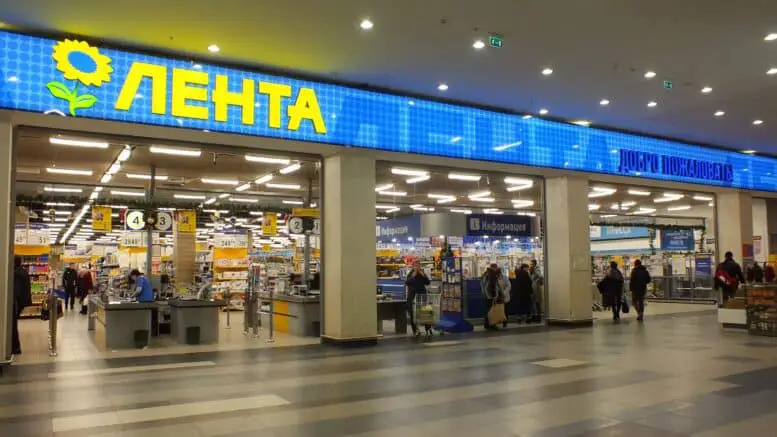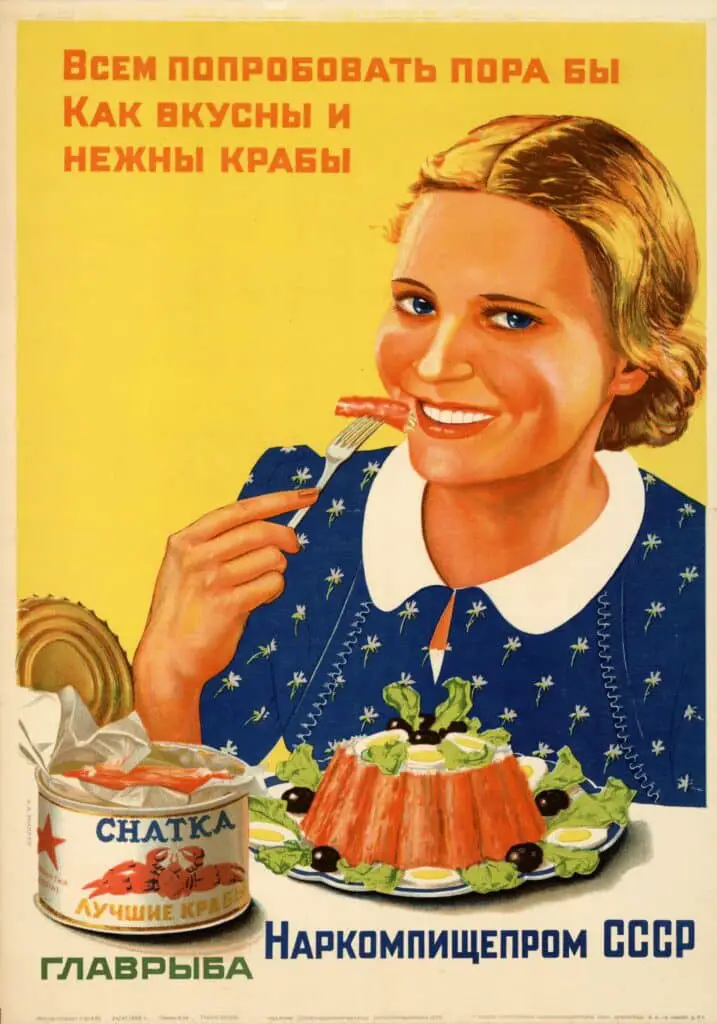In the past century, Russia has experienced different economic systems and many societal changes. One industry that reflects this, perhaps more than any other, is retail food. Essential for life, the history of food production, distribution, and availability is often tied to the history of great societal shifts. Hunger, or the fear of hunger, can help drive revolution, while prosperity can perhaps be most directly felt in the availability of widely diverse products in the marketplace, which represent expanding and diversifying trade and production.
From state-organized distribution in the USSR, to rationing in the 1980s, to nascent capitalism and the entry of foreign firms, to a booming industry dominated by Russian-owned supermarkets, food distribution has gone through many different phases for everyday Russians.
Shopping in the Soviet System
With the advent of the Soviet Union, the world witnessed the creation of an entirely new way of organizing an economy. While the collectivization of farms and the disastrous early consequences of that policy are widely known, stores and logistical networks were also nationalized and placed under state control, as were advertising and marketing.
In major cities, department stores existed, but in smaller towns Soviet citizens went to separate places for different products like bread or milk. In global perspective, this isn’t so strange. The supermarket was invented in America and only became common there in the 1940s. The idea spread to Western Europe post-WWII and gradually spread. Khrushchev attempted to bring the concept to the USSR after visiting America in the 1960s, but Soviet production and distribution systems were unable to produce a widespread supermarket system. Throughout the Soviet period, most Soviet citizens (like most people in the “non-Western” world) shopped at small, often specialized service counters, where products were fetched by the clerk rather than pulled independently from shelves, as Americans did in the early 1900s.
Soviet products featured labels that were generally small, plain, and descriptive, but again not all that different from contemporary products in western countries. Although most was very generic, some packaging and design developed by the Soviets has lived on as iconic examples of popular food culture, including the innovative “Soviet milk pyramid.” Similarly, packaging labels for Rogachev sweetened condensed milk and Druzhba cheese remain recognizable by most Russians, and are still available for purchase in forms that haven’t changed over many decades, similar to Campbell’s Soup in America.
Advertising was colorful and sometimes similar to contemporary American advertising. A perhaps surprising number of advertisements featured general products rather than specific brand names. Many Soviet advertisements focused on supporting entire industries, such as sausage, milk, or ice cream, rather than the products of a particular factory.
While the Soviet system worked for a time, systemic issues caused problems further down the line. Although the USSR established a set of food standards called GOST that are still followed and widely respected today, not all food was produced and sold under the standards. Ambitious production targets, set by the state under five-year plans, often encouraged corners to be cut and thus many goods came to be sold with suspect quality.
Soviet stores, in an attempt to curb low-level corruption, operated under a system that often resulted in long lines. The system spread responsibility for each sale over three people and the customer went through three lines at the market. Customers got a ticket for the product from the first line, paid in the next, and presented the receipt and received the product in the last line.
Hidden Inflation: A Growing Problem for the System
Prices for food, like for all other products in the USSR, were standardized and set by the government. As one might assume in a politically-run economy, prices were almost never raised, while incomes increased over time. While obviously unsustainable, the system kept the Soviet citizenry happy. In order to issue salaries, the central bank simply printed more money. This led to “hidden inflation,” wherein the currency became devalued but could not result in raised prices because prices were legally mandated. This meant that the rising costs of wages were eventually taken from production, resulting in decreasing supply. Combine this hidden inflation with central planning that did not often take into account how well crops would grow in certain soil and climactic conditions, and the stage was set for eventual shortages.
These shortages occurred with some frequency, especially after the 1960s, a decade of relative prosperity in the Soviet Union. By the 1980s they had become a major object of public concern. Runs on available products were common. Shortages also contributed to a burgeoning underground economy, in which people exchanged items and favors with one another. People often carried around avoska bags—compact, reusable string bags common before the arrival of plastic bags. People used these to carry purchases, allow for unexpected finding of available products, or even to pick up any produce that might fall from supply trucks.
The results of shortages and hidden inflation can best be seen in the local markets that carried produce grown privately on private plots. Here, prices were not regulated and were thus much higher than in official stores; they were closer to what market value had reached, although officials would argue that prices were driven by individual greed. The markets were fairly common and officially tolerated—even supported—to ensure a stable food supply.
Hidden inflation also drove the Soviet government to find ways to sell products abroad at market prices. The government wanted to obtain foreign currency, which allowed its cash supply to increase, exacerbating inflationary pressures.
Although the logic for opening them is still a state secret, Beryozka stores were one state source of foreign currency. At Beryozka stores, tourists, diplomats, sailors returning from abroad, and others with foreign currency could purchase goods with that currency (or ruble-denominated vouchers the currency would be first exchanged for). Elites whose jobs enabled them to leave the Soviet Union and acquire foreign currencies were perhaps the best-known shoppers here.
Rationing: The Beginning of the End
The Soviet system of food distribution ran into big trouble early in the 1980s. Droughts in 1982 brought poor harvests that, combined with a US embargo in place since 1980, caused massive shortages. General inefficiencies such as aging farm equipment did not help either. One study estimated that 20% of most Soviet grain harvests was typically lost to rot because of late harvesting or poor storage. Soviet officials recognized the severity of the problem, with General Secretary Leonid Brezhnev saying that food was the main issue for the country to deal with in the 1981-1985 Five Year Plan. Hoarding compounded the issue even further as people sought to protect their personal interests.
These shortages led to a rationing system that greatly affected the Soviet people. Within the capital, Moscow, this was largely informal, with store managers setting limits . Elsewhere, the system had a more official structure with ration coupons. The ration system stopped some people from getting to the stores early and buying up everything before others had a chance to get a share, but corruption still enabled government officials and those with connections to get early access, partly circumventing the system and, again, compounding the issue for common people. Some have alleged that corrupt managers even caused shortages on purpose, in order to discredit Perestroika reforms.
The Rough Transition to Capitalism
As the Soviet Union continued to struggle with food shortages and hunger, the United States under President George H.W. Bush approved a plan in 1991 to provide grain aid to the Soviets. Mere months later, however, the Soviet Union collapsed, with republics declaring their independence one by one. American food aid continued throughout the 1990s, despite fears that it would help prop up the old, inefficient system.
In the newly minted Russian Federation, the transition to capitalism was abrupt, with communism collapsing nearly overnight. It took with it state subsidies and state-mandated prices. The tightly-wound spring of hidden inflation was released all at once. The country felt this almost immediately, with inflation reaching a historic maximum in 1993 at 2350%.
Most farms entered the era with no money with which to buy seed or invest in capital. In addition, the new country had little experience with private enterprise or commercial banking. Thus, many collective farms were simply abandoned, despite soaring prices. Higher-end food production, such as livestock, fell dramatically due to growing poverty and high income elasticity. Soviet distribution systems collapsed and stores struggled to keep enough product on the shelves to pay their own bills. Russian consumers coped by increasing production on privately-owned plots of land and also increasing their expenditures on food as a percentage of income.
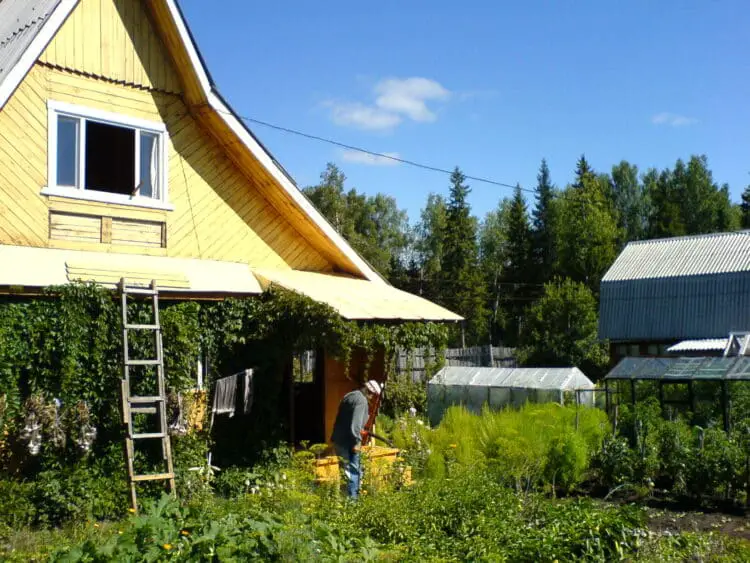
Garden by a privately-owned dacha. Photo from Wikimedia Commons
To maintain the food supply, the newly post-Soviet Russia turned to a tried-and-true method: the local market. These grew and proliferated in public spaces with a significant amount of empty space and high foot traffic. Stadiums and major squares constituted prime candidates. Cherkizovsky market in Moscow, for example, grew to be Europe’s largest public market, with thousands of traders.
Many individual sellers became “suitcase importers.” Hard to find items were brought into the country in suitcases and sold at individual stands. A barrage of brand names from a variety of countries flooded the market.
The sudden collapse of the USSR also left a political vacuum that was not quickly filled. The new government struggled not only to found viable institutions to formulate economic and monetary policy, but also in the more basic functions of simply enforcing regulation and taxation and providing services. Markets, which became major economic centers, often with hundreds of individuals transacting business, proved particularly difficult to regulate and soon became incubators for criminal gangs. Products were often counterfeit or contraband. Shoppers, concerned about safety, often took care to choose trusted individual sellers and products. While most Russians still flocked to markets as their major sources of food, they became increasingly known as rough and unruly areas.
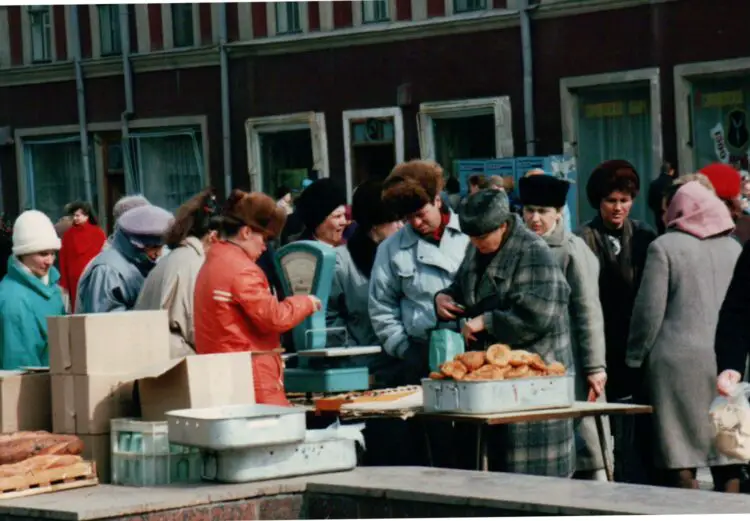
An open-air market in Russia in 1992. Photo from Wikimedia Commons
As Russia developed and stabilized, these markets have often been subject to government raids and even forced closures in an attempt to enforce regulations and protect legitimate commerce. Many closed as more competitive modern stores entered the market. Cherkizovsky, for instance, was forcibly closed in 2009 after numerous instances of selling counterfeit goods and tax evasion.
Foreign Firms Enter the Market
Market stabilization had its beginning around 2000-2003. This featured political change as the state tightened its control of institutions and the economy. Rising oil prices, combined with a government now able to provide basic services and increasingly able to enforce regulations and taxation, gradually fueled the Russian economy again. The country finally brought inflation back under control with a focused state monetary policy.
Foreign firms, seeing the giant and undeveloped Russian market stabilizing, began to cautiously trickle in. Two of the first major players included Auchan, a French company, and Stockman, a Finnish company. Foreign firms such as these have had conflicting fortunes in Russia.
An academic paper identified three “stages” of foreign firms entering the Russian retail market. In the first two stages, foreign enterprises came into the country and expanded rapidly. Auchan opened its first store in Russia in 2002. It has grown to include 311 stores with 41,000 employees. Innovation has been a hallmark of the company’s business model—in 2009 Auchan launched its new Raduga brand. Raduga stores, usually located in mid-sized cities, feature fully automated checkout lines, which are still rare in Russia. Auchan has recently expanded operations in the country and consumers consistently rank the store highly. One challenge the store has faced, however, is that as the market as matured, Russians increasingly favor smaller and more convenient neighborhood stores rather than the giant format that Auchan is famous for in Russia. The brand has struggled to push into smaller formats, but still does well with its hyperstores. One estimate puts Auchan’s overall market share for retail food in Russia in 2016 at 5.7%, with a projected increase to 7.2% by 2021. It is still an example of a foreign firm operating successfully in Russia.
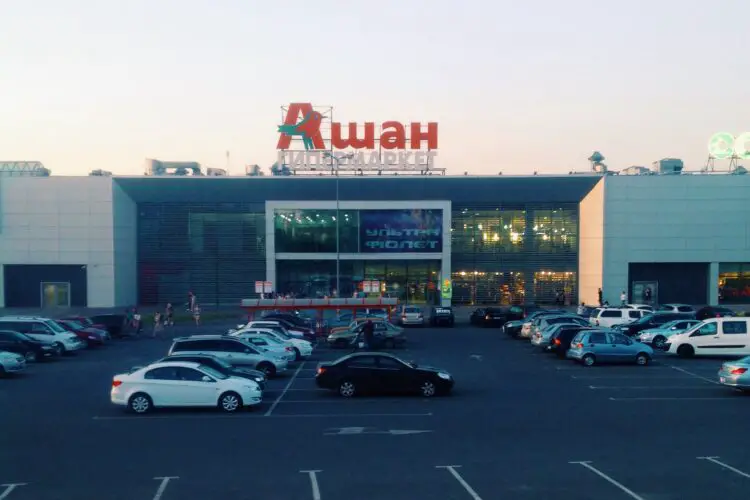
Exterior of an Auchan hypermarket in Russia. Photo from Википедиа
Meanwhile, Stockmann has completely left the market. In many ways, Stockmann’s history was marked by a failure to innovate. When it opened its first store in Moscow in 1998, it specialized in importing foreign brands and selling them at high markups. As the market matured, however, and many items became more commonly found on the shelves of lower-priced competitors, Stockmann failed to find another niche to occupy. It thus fell victim to the third stage of foreign retail involvement in Russia: slowdown ahead of market consolidation. Although it had grown steadily, with particular success between 2007 and 2009, sanctions, market substitution, and the devaluation of the ruble hurt importers like Stockmann especially hard. The firm withdrew from Russia in 2015.
Rise of Russian Supermarkets
Market consolidation has been rapid, with Russian-owned chains leading the way. The modern supermarket was relatively rare in Russia even in the early and mid-2000s. By 2018, however, supermarkets had reached market saturation and were now commonplace.
Initially, the market contained many players, but consolidation has seen larger firms swallow up smaller and less efficient ones. The most successful of these used rising local production and expanding local distribution networks to their fullest advantage. However, a fair amount of fragmentation still exists, as the top five brands collectively have only 24% market share. This is still much below the 60% thresholds that top players in more developed markets usually attain. This can be explained, in part, by Russia’s particular demographic and geographic conditions. Many of the largest brands are found mostly west of the Ural Mountains, where logistics are easier and population density is much greater. Siberia and the Russian Far East have been largely neglected by the retail giants, but do have many smaller chains developing networks which may, over time, become acquisition targets for larger chains.
The two major players today are X5 Retail Group and Magnit. X5 operates a few popular brands: Perekrestok, Pyaterochka, and Karusel. Pyaterochka is a range of lower-priced, smaller, neighborhood stores that accounts for the bulk of X5’s locations. Around 600 supermarkets run under the mid-range Perekrestok brand. Finally, Karusel is X5’s hypermarket chain. X5 is a publicly traded company, but largely controlled by Alfa Group holdings, a massive conglomerate heavily associated with Russian billionaire Mikhail Fridman.

Perekrestok, a popular supermarket. Photo from Википедиа
Meanwhile, Magnit is X5’s biggest competitor. It launched in Krasnodar and focused on smaller cities outside of Moscow and St. Petersburg at a time when most major brands did just the opposite. With a focus on keeping logistics efficient and prices low, it had explosive growth. Sergei Galitsky founded and ran the company for a long time, but after disagreements with stockholders, he has since stepped down and majority ownership has been taken over by VTB Bank. Some analysts have speculated this might create issues for the effective management of the brand later.
There are also a number of other, smaller chains. Some are large-format stores such as Lenta and Okei. Lenta is another foreign-owned business, launched with capital from the United States and European Union. Dixy is a major small-format brand that has focused especially on low-income areas. Some others are specialty stores focused in or around major cities such as Azbuka Vkusa, which still stands out as a major importer and seller of high-end groceries. VkusVill is new, but rapidly expanding out of Moscow, filling a niche for fresh, local food and which has greatly benefited from recent geopolitical events. Finally, Krasnoe i Beloe focuses heavily on selling alcohol while maintaining enough non-alcoholic products to still be classified as a grocery store.
Geopolitics and Russian Refrigerators
Sanctions have generally meant advantages for locally-owned brands in Russia. In retaliation for US and EU sanctions against Russian businesses and individuals, Russia banned the import of certain foods from sanctioning countries. At the same time, political pressure and rapidly falling oil prices led the government to allow the ruble to “float,” or attain its true market value, for the first time in more than a decade. As had been the case with “hidden inflation,” government regulation had created a substantial warp in the market and Russians saw their currency lose about half its value, but then rapidly stabilize on international exchanges in a few short months.
Russia’s agricultural industry is still recovering from the chaos left by the Soviet collapse. Land codes and other regulations floundered, preventing wide-spread investment and leaving the country ever more dependent on imports. However, with many imports suddenly banned and those still legally accessible now vastly more expensive, logistics networks were again scrambled.
The Russian consumer saw inflation rapidly rise to 16%, with food inflation hitting 25% by the end of 2015. However, Russia’s new chains and logistics networks proved remarkably elastic. Many brands disappeared from shelves but were then replaced by brands imported from less expensive regions. U.S. agricultural exports to Russia saw an 80% decrease, including one of Russia’s major sources of poultry.
Perhaps most dramatically, the rise in prices happened at a time when Russian businessmen had gained years of experience, when Russia’s commercial banking system was maturing, and as Russia’s government was finally turning its attention towards agricultural reform. Logical market reactions were quick to set themselves in motion. Large local firms such as Miratorg, now one of the world’s largest producers of meat, have taken the opportunity to rapidly expand. A range of new dairy producers have launched and massive investment is now underway into modern greenhouses for intensive cultivation of vegetables.
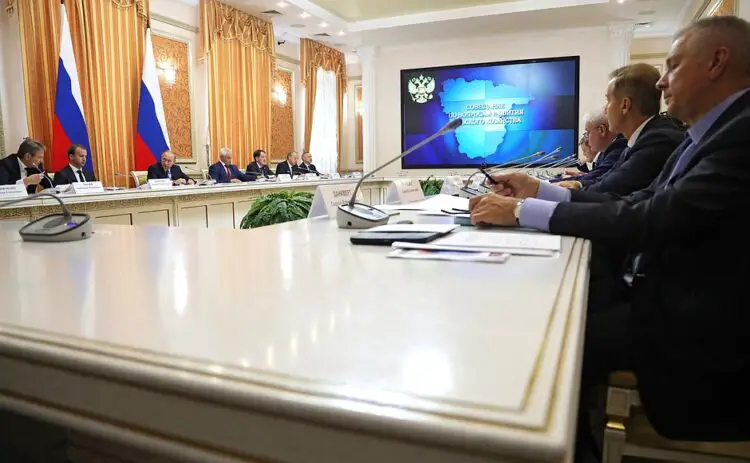
Meeting on the subject of agricultural development in Voronezh Oblast–an important topic in light of the import ban. Photo from President of Russia
The Russian population, perhaps partly immune to the effects of inflation after the 1990s, also remained remarkably calm during this dramatic economic shift. While there some hoarding occurred amid rapid inflation, Russian grocery stores and banks remained, for the most part, civilized places with individuals making rational decisions. Food inflation fell again to 5% by 2016, and has largely tracked just above national inflation since then.
While domestic production is rising and local supermarket brands are flourishing, it is still difficult to get crops to market in a country that covers 17.1 million square kilometers. In fact, infrastructure has been identified by Minister of Economic Development Maxim Oreshkin as one of the key issues facing the country. Russia languishes far below other European countries in infrastructure quality—according to the World Bank’s Logistics Performance Index (LPI) it lies between Djibouti and Argentina. To counter this issue, President Putin has announced a multi-billion dollar plan to invest in transport infrastructure. This is a major problem that needs to be addressed in order for the country to continue growing.
Future Developments
The chronicles of Russian economic history, in general, have been a study in contrasts and constant change. Nowhere is this more exemplified, perhaps, than in the food industry. As the grocery store industry continues to thrive, it is likely to become even more consolidated, with Russian chains showing clear advantages in the local market. Meanwhile, domestic food production will continue to increase, as there is no end to tensions with the United States and European Union in sight, and thus no end to sanctions or the counter-sanctions right now favoring domestic Russian firms. Although the market is greatly affected by political forces, capitalism has well and truly taken hold in Russia’s supermarkets. The level of competition is healthy and pushes all of the firms to innovate and draw in new customers. From a state-controlled system that eventually failed, to nascent capitalism, to a healthy industry, food in Russia has undergone tumultuous times.


